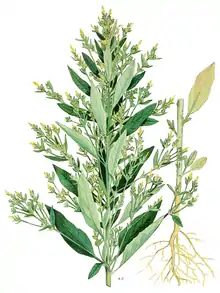| Axyris | |
|---|---|
 | |
| Axyris amaranthoides botanical illustration | |
| Scientific classification | |
| Kingdom: | Plantae |
| Clade: | Tracheophytes |
| Clade: | Angiosperms |
| Clade: | Eudicots |
| Order: | Caryophyllales |
| Family: | Amaranthaceae |
| Subfamily: | Chenopodioideae |
| Tribe: | Axyrideae |
| Genus: | Axyris L.[1] |
| Species | |
|
See text | |
| Synonyms | |
| |
Axyris, the Russian pigweeds, are a genus of flowering plants in the amaranth family Amaranthaceae, native to temperate parts of Eastern Europe and Asia. The center of genetic diversity is the Altai to northern Tien-Shan mountains.[2] The best known species is Axyris amaranthoides, which has become a widespread invasive in northern North America.
Species
Currently accepted species include:
- Axyris amaranthoides L.
- Axyris caucasica (Sommier & Levier) Lipsky
- Axyris hybrida L.
- Axyris koreana Nakai
- Axyris mira Sukhor.
- Axyris prostrata L.
- Axyris sphaerosperma Fisch. & C.A.Mey.
References
- ↑ Sp. Pl.: 979 (1753)
- ↑ Sukhorukov, Alexander P. (2011). "Axyris (Chenopodiaceaes s.str. or Amaranthaceaes s.l.) in the Himalayas and Tibet". Willdenowia. 41: 75–82. doi:10.3372/wi.41.41108. S2CID 83822100.
This article is issued from Wikipedia. The text is licensed under Creative Commons - Attribution - Sharealike. Additional terms may apply for the media files.